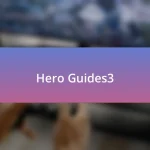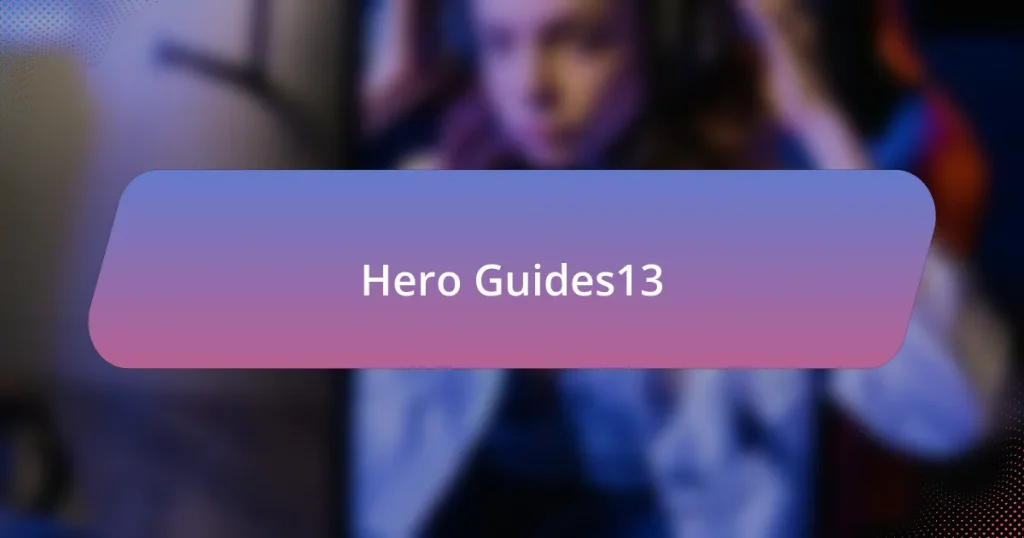Mastering the Mid Lane is a critical aspect of gameplay in multiplayer online battle arena (MOBA) games, particularly in titles like League of Legends and Dota 2. This article explores the strategic importance of the mid lane, detailing key elements such as wave management, map awareness, and champion mechanics. It highlights the impact of mid lane control on overall gameplay, team dynamics, and map objectives, while also identifying essential skills and strategies for success. Additionally, the article discusses the strengths of top mid lane heroes in the current meta and provides insights into effective hero selection and gameplay techniques to enhance performance in this pivotal role.

What is Mastering the Mid Lane?
Mastering the Mid Lane refers to the strategic and skillful play required to dominate the central lane in multiplayer online battle arena (MOBA) games, particularly in titles like League of Legends and Dota 2. This involves understanding champion mechanics, map awareness, and effective trading against opponents. Players who excel in the mid lane often utilize specific heroes known for their burst damage and crowd control, such as Zed or Lina, to secure kills and control objectives. Mastery in this role is validated by the ability to consistently out-farm opponents, secure vision control, and influence other lanes through effective roaming.
How does mastering the mid lane impact overall gameplay?
Mastering the mid lane significantly enhances overall gameplay by providing strategic advantages such as map control, increased gold and experience gain, and the ability to influence other lanes. A skilled mid laner can secure early kills, which not only boosts their own resources but also creates opportunities for their team to capitalize on the enemy’s weakened state. Additionally, mid lane champions often have high mobility and crowd control abilities, allowing them to roam effectively and assist teammates in securing objectives. This impact is evidenced by statistics showing that mid lane champions frequently contribute to a higher percentage of team kills and assists, thereby shaping the outcome of matches.
What roles does the mid lane play in team dynamics?
The mid lane plays a crucial role in team dynamics by serving as a central point for map control, resource allocation, and strategic decision-making. Mid lane champions often have high mobility and burst damage, allowing them to influence other lanes through roams and securing objectives like the Dragon or Baron. This central position enables the mid laner to provide vision and control over key areas of the map, facilitating team fights and skirmishes. Additionally, the mid lane often serves as a source of damage output and crowd control, which are essential for team engagements. The effectiveness of the mid lane can significantly impact the overall performance and coordination of the team, as evidenced by professional matches where mid lane dominance often correlates with victory.
How does mid lane control influence map objectives?
Mid lane control significantly influences map objectives by allowing a team to secure vision and pressure across the map. When a team dominates the mid lane, they can effectively rotate to other lanes and objectives, such as dragons or Baron, with greater ease and safety. This control enables the team to establish vision in key areas, making it harder for the opposing team to contest objectives. Additionally, mid lane champions often have abilities that can impact team fights and skirmishes around these objectives, further solidifying the importance of mid lane dominance in overall map strategy.
What are the key elements of mid lane mastery?
The key elements of mid lane mastery include wave management, map awareness, champion knowledge, and effective trading. Wave management involves controlling minion waves to deny the opponent farm and create opportunities for ganks. Map awareness is crucial for tracking enemy movements and anticipating threats, which can be enhanced by regularly checking the minimap and using wards. Champion knowledge entails understanding the strengths and weaknesses of both your champion and your opponent’s, allowing for strategic decision-making during trades and skirmishes. Effective trading requires knowing when to engage or disengage based on cooldowns and health advantages, which can lead to securing kills or gaining lane dominance.
What skills are essential for a successful mid lane player?
Essential skills for a successful mid lane player include strong map awareness, effective communication, and proficient mechanics. Map awareness allows players to track enemy movements and anticipate ganks, which is crucial for survival and strategic positioning. Effective communication with teammates enhances coordination during team fights and objective control. Proficient mechanics, such as last-hitting minions, skill-shot accuracy, and ability combos, directly impact a player’s ability to secure kills and maintain lane dominance. These skills collectively contribute to a mid lane player’s overall effectiveness in the game.
How do mechanics differ between various mid lane heroes?
Mechanics differ significantly between various mid lane heroes due to their unique abilities, playstyles, and roles within the game. For instance, assassins like Zed rely on burst damage and mobility to quickly eliminate targets, utilizing skills that allow them to reposition and escape after engagements. In contrast, mages such as Orianna focus on area control and sustained damage, employing skill shots and crowd control to manipulate team fights and zone enemies. Furthermore, tanky mid lane heroes like Galio prioritize durability and initiation, using their abilities to absorb damage and protect allies while disrupting enemy formations. Each hero’s mechanics dictate their approach to laning, trading, and team fights, making understanding these differences crucial for effective gameplay.

Which heroes are considered key in the mid lane?
Key heroes in the mid lane include heroes like Invoker, Queen of Pain, and Storm Spirit. These heroes are pivotal due to their high burst damage, mobility, and ability to control the game through effective ganking and team fight contributions. For instance, Invoker’s versatility with spells allows for various playstyles, while Queen of Pain’s mobility and damage output make her a formidable opponent in one-on-one situations. Storm Spirit’s ability to initiate fights and escape danger further solidifies his importance in the mid lane.
What are the top mid lane heroes currently in the meta?
The top mid lane heroes currently in the meta include Azir, Lina, and Storm Spirit. Azir excels due to his high damage output and ability to control team fights with his ultimate, while Lina offers burst damage and crowd control, making her a strong pick for securing kills. Storm Spirit is favored for his mobility and ability to initiate fights, allowing him to capitalize on enemy positioning. These heroes have consistently shown strong win rates and effectiveness in competitive play, validating their status in the current meta.
What strengths do these heroes bring to the mid lane?
Heroes in the mid lane bring a variety of strengths, including high burst damage, crowd control, and mobility. High burst damage allows these heroes to quickly eliminate enemy heroes, creating opportunities for early kills and map control. Crowd control abilities enable them to disrupt enemy movements and secure kills or escape from dangerous situations. Mobility enhances their ability to roam and assist other lanes, increasing overall team effectiveness. For example, heroes like Zed and LeBlanc excel in burst damage and mobility, while heroes like Lina and Queen of Pain provide strong crowd control and damage output. These strengths collectively contribute to dominating the mid lane and influencing the game’s outcome.
How do hero matchups affect mid lane strategy?
Hero matchups significantly influence mid lane strategy by determining the effectiveness of champions against each other. For instance, a champion with strong crowd control can dominate a matchup against a squishy opponent, forcing them to play defensively. This dynamic affects the choice of abilities, item builds, and overall playstyle. Players often adapt their strategies based on the strengths and weaknesses of their chosen heroes, such as prioritizing aggression against weaker opponents or focusing on farming and survival against stronger ones. Historical data shows that specific matchups can lead to a higher win rate for one champion over another, reinforcing the importance of understanding these interactions in competitive play.
How do players choose the right hero for their playstyle?
Players choose the right hero for their playstyle by assessing their preferred gameplay mechanics and strategies. This involves evaluating factors such as aggression, defense, mobility, and team synergy. For instance, a player who enjoys aggressive play may select heroes with high damage output and crowd control abilities, while a player who prefers a supportive role might choose heroes that provide healing or utility. Additionally, players often analyze their team’s composition and the opposing heroes to ensure their choice complements the overall strategy. This strategic selection process is supported by data from player performance metrics, which indicate that aligning hero choice with individual playstyle significantly enhances game effectiveness and satisfaction.
What factors should be considered when selecting a mid lane hero?
When selecting a mid lane hero, players should consider the hero’s abilities, matchups, team composition, and playstyle. The abilities of a hero determine their effectiveness in dealing damage, crowd control, and survivability, which are crucial for mid lane dominance. Matchups against opposing heroes can significantly influence the lane’s outcome; understanding the strengths and weaknesses of both heroes helps in making informed decisions. Team composition is also vital, as a mid lane hero should complement the overall strategy and synergy of the team. Lastly, the player’s preferred playstyle—whether aggressive or defensive—should align with the chosen hero to maximize performance and impact in the game.
How does team composition influence hero selection?
Team composition significantly influences hero selection by determining the roles and synergies needed for effective gameplay. A balanced team typically requires a mix of damage dealers, tanks, and support heroes, which guides players in choosing heroes that complement each other’s strengths and weaknesses. For instance, if a team lacks crowd control, players may prioritize heroes with abilities that can immobilize or disrupt opponents, ensuring better team fights. Additionally, specific hero matchups against opponents can dictate selections; for example, if the enemy team has a strong physical damage dealer, selecting heroes with high armor or defensive capabilities becomes crucial. This strategic alignment ensures that the team can execute its game plan effectively, maximizing the potential for victory.

What strategies are effective for mastering the mid lane?
Effective strategies for mastering the mid lane include wave management, map awareness, and champion mastery. Wave management involves controlling minion waves to deny the opponent farm and create opportunities for ganks. Map awareness is crucial for avoiding enemy ganks and positioning for objectives, which can be enhanced by regularly checking the minimap and using wards. Champion mastery requires understanding the strengths and weaknesses of your chosen champion, including optimal ability usage and item builds, which can lead to better performance in trades and team fights. These strategies are supported by the fact that players who effectively manage their waves and maintain high map awareness tend to have higher win rates, as evidenced by data from platforms like OP.GG and League of Graphs.
How can players improve their laning phase in the mid lane?
Players can improve their laning phase in the mid lane by focusing on last-hitting minions, maintaining proper vision control, and understanding matchups. Last-hitting minions ensures players gain gold and experience efficiently, which is crucial for scaling. Maintaining vision control through wards helps prevent ganks and allows players to track enemy movements, enhancing safety and decision-making. Understanding matchups enables players to exploit their champion’s strengths and weaknesses against the opponent, leading to better trades and positioning. These strategies are supported by the fact that effective last-hitting can increase a player’s gold income by up to 30% in the early game, while proper vision can reduce deaths from ganks by approximately 50%.
What techniques can be used to secure farm and experience?
To secure farm and experience in the mid lane, players should utilize techniques such as last-hitting minions, zoning opponents, and controlling vision. Last-hitting minions ensures that players gain gold and experience without pushing the lane unnecessarily, which can expose them to ganks. Zoning opponents involves positioning oneself to threaten enemy champions, discouraging them from approaching minions and thus denying them farm and experience. Controlling vision through wards allows players to anticipate enemy movements, reducing the risk of ambushes and enabling safer farming. These techniques are essential for maintaining an advantage in the mid lane, as they directly impact a player’s resource accumulation and overall effectiveness in the game.
How can players effectively trade damage with opponents?
Players can effectively trade damage with opponents by timing their abilities and positioning strategically. Effective trading involves using abilities when opponents are vulnerable, such as after they have used their own abilities or when they are overextended. Additionally, players should maintain optimal positioning to minimize incoming damage while maximizing their own output. For instance, in games like League of Legends, champions with crowd control can initiate trades when the opponent is unable to retaliate, leading to favorable damage exchanges. This approach is validated by the fact that players who understand their champion’s power spikes and cooldowns can consistently outmaneuver opponents, resulting in higher win rates in mid-lane matchups.
What are the best practices for roaming from the mid lane?
The best practices for roaming from the mid lane include timing your movements after pushing the wave, using vision control to avoid ganks, and communicating with your team. Pushing the wave ensures that you have priority, allowing you to roam safely without losing farm. Vision control, such as placing wards in key areas, helps to prevent enemy ambushes and provides information on enemy movements. Effective communication with teammates, particularly the jungler, increases the chances of successful ganks and objectives. These practices are supported by the fact that mid lane champions often have high mobility and can influence other lanes significantly, making strategic roaming essential for overall team success.
How can mid lane players effectively coordinate with their team during roams?
Mid lane players can effectively coordinate with their team during roams by utilizing clear communication and map awareness. By pinging their intentions and informing teammates of their movements, mid lane players can create opportunities for ganks or objective control. Additionally, maintaining vision control through wards allows the team to anticipate enemy movements and respond accordingly. Studies show that teams with effective communication and vision control have a higher win rate, emphasizing the importance of these strategies in successful gameplay.
What signs indicate a good time to roam from the mid lane?
A good time to roam from the mid lane is indicated by the enemy mid laner being absent or low on health, as well as the presence of opportunities in other lanes. When the enemy mid laner leaves the lane, it creates a window for the mid laner to assist teammates in securing kills or objectives. Additionally, if the mid laner has pushed their wave to the enemy tower, they can roam without losing significant farm. These signs are crucial because they allow for strategic advantages, such as gaining vision control or applying pressure elsewhere on the map, which can lead to favorable outcomes in team fights or objectives.
What tips can help players master the mid lane?
To master the mid lane, players should focus on wave management, map awareness, and champion knowledge. Effective wave management involves last-hitting minions to maintain control over the lane and prevent the enemy from gaining an advantage. Map awareness is crucial; players should regularly check the minimap to anticipate ganks and coordinate with their jungler. Understanding the strengths and weaknesses of their chosen champion, as well as those of their opponent, allows players to make informed decisions during trades and skirmishes. These strategies are supported by the fact that players who effectively manage their waves and maintain high map awareness typically achieve higher win rates in mid lane matchups.
How can players analyze their gameplay to improve mid lane performance?
Players can analyze their gameplay to improve mid lane performance by reviewing match replays and focusing on key metrics such as CS (creep score), kill/death ratio, and map awareness. By examining replays, players can identify mistakes, such as poor positioning during trades or missed opportunities for ganks, which directly impact their effectiveness in the mid lane. Additionally, tracking CS helps players understand their farming efficiency compared to opponents, while analyzing kill/death ratios provides insight into their engagement decisions. Studies show that players who regularly review their gameplay and focus on these metrics tend to see significant improvements in their performance, as they can adapt their strategies based on concrete evidence from their own games.
What common mistakes should mid lane players avoid?
Mid lane players should avoid overextending without vision. Overextending can lead to easy ganks from the enemy jungler or mid laner, resulting in significant disadvantages such as losing gold and experience. According to data from high-level gameplay analysis, players who maintain proper vision control and positioning are 30% less likely to be caught out and killed, which directly impacts their ability to farm and scale into the late game effectively.












